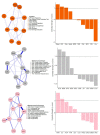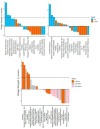Bridging Brain and Cognition: A Multilayer Network Analysis of Brain Structural Covariance and General Intelligence in a Developmental Sample of Struggling Learners
- PMID: 34204009
- PMCID: PMC8293355
- DOI: 10.3390/jintelligence9020032
Bridging Brain and Cognition: A Multilayer Network Analysis of Brain Structural Covariance and General Intelligence in a Developmental Sample of Struggling Learners
Abstract
Network analytic methods that are ubiquitous in other areas, such as systems neuroscience, have recently been used to test network theories in psychology, including intelligence research. The network or mutualism theory of intelligence proposes that the statistical associations among cognitive abilities (e.g., specific abilities such as vocabulary or memory) stem from causal relations among them throughout development. In this study, we used network models (specifically LASSO) of cognitive abilities and brain structural covariance (grey and white matter) to simultaneously model brain-behavior relationships essential for general intelligence in a large (behavioral, N = 805; cortical volume, N = 246; fractional anisotropy, N = 165) developmental (ages 5-18) cohort of struggling learners (CALM). We found that mostly positive, small partial correlations pervade our cognitive, neural, and multilayer networks. Moreover, using community detection (Walktrap algorithm) and calculating node centrality (absolute strength and bridge strength), we found convergent evidence that subsets of both cognitive and neural nodes play an intermediary role 'between' brain and behavior. We discuss implications and possible avenues for future studies.
Keywords: brain structural covariance; cognitive network neuroscience; cortical volume; fractional anisotropy; general intelligence; multilayer network analysis.
Conflict of interest statement
E.T.B. is a member of the scientific advisory board of Sosei Heptares.
Figures






References
-
- Akarca Danyal, Vértes Petra E., Bullmore Edward T., the CALM Team. Astle Duncan E. A Generative Network Model of Neurodevelopment. BioRxiv. 2020 doi: 10.1101/2020.08.13.249391. - DOI
-
- Alloway Tracy P. Automated Working Memory Assessment (AWMA) Harcourt Assessment; London: 2007.
-
- Amestoy Patrick R., Azzalini Adelchi, Badics Tamas, Benison Gregory, Bowman Adrian, Böhm Walter, Briggs Keith, Bruggeman Jeroen, Buchmueller Juergen, Butts Carter T., et al. Igraph: Network Analysis and Visualization (Version 1.2.6) [(accessed on 11 June 2021)];2020 Available online: https://CRAN.R-project.org/package=igraph.
Grants and funding
LinkOut - more resources
Full Text Sources

